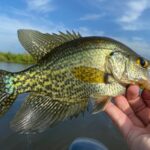In the wide world of fishing, there are no shortage of lures for an angler to choose from. In fact, just in the ever popular bass fishing community, there are literally hundreds of lures on the market today.
Two of the most common, and sometimes misunderstood are the Jerkbait and the Crankbait.
In this article, im going to clearly explain the differences between the two, and more importantly, explain how to fish each style of lure, when you should choose a jarkbait vs crankbait and much more.
By the end of this article, you’ll have a clear understanding and you’ll be more prepared and successful on your next fishing trip.
Table of Contents
What is the difference between a Jerkbait and Crankbait?
A Jerkbait is a narrow shaped hard-body lure with with a shallow lip and 2-3 treble hooks, usually fished in depths of 6 feet or less. A crankbait is a compact shaped hard-body lure, with 1-2 treble hooks and varying lip sizes for shallow, medium or deep water fishing.
Both lures are hard baits with some sort of bill, and both are diving baits but it is the shape, action and depth that distinguihses them apart.
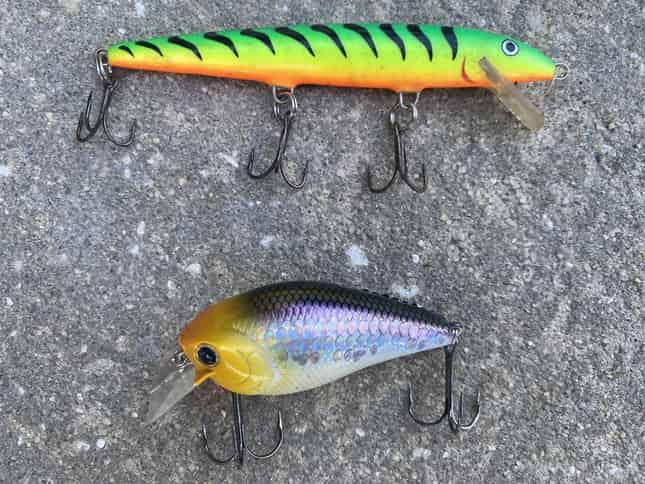
Jerkbaits are usually fished with an erratic retireve, that can include swining the rod tip downward, pauses and fast retreival. This erratic action is often what triggers a strike.
Crankbaits are usually fished with a retrieval steady speed, and rely on their distinch vibration and wobbling action to trigger a strike.
Both lures can be extremely effective, especially for predatory species such as largemouth bass, musky and pike.
Jerkbait Variations & Types
A few of the most popular variations of jerkbaits are suspending jerkbaits, floating jerkbaits, and sinking jerkbaits.
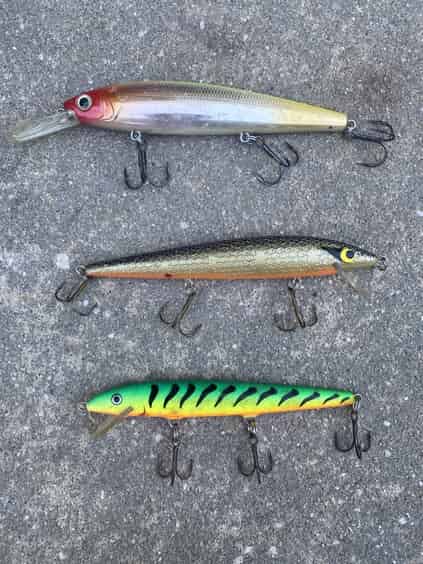
Suspending Jerkbaits
Suspending jerkbaits do what the name implies, and they suspend on the pause. This allows you to pause the bait, without the bait changing levels in the water column. Giving the angler the opportunity to pause the bait longer which can elicit more strikes.
Floating Jerkbaits
Floating jerkbaits, unlike suspending jerkbaits will float to the top of the water on your pauses. This floating action allows the angler to fish the bait shallower, which can be a great option as the weather transitions from spring to summer as fish start moving shallower.
Sinking Jerkbaits
Sinking Jerkbaits come in different weights allowing the angler to adjust the sink rate of the lure. Depending on how heavy your lure is, the lure may sink a few inches on the pause or it may stay at the same relative level.
One pro of a sinking jerkbait is that it allows the angler to cover different depths of water with the same lure.
Crankbait Variations & Types
Just like Jerkbaits, crankbaits come in an assortment of variations as well. However they can be broken up into three different groups, Squarebills, Roundbills, and Lipless crankbaits.
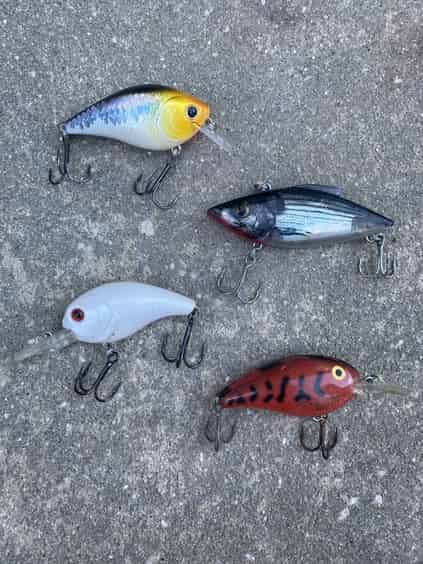
Square BIll Crankbaits
Square bill crankbaits generally have a smaller bill than those of the round bill crankbaits, making this lure excel in shallow water, and heavy cover.
The square bill crankbait puts off a ton of vibration, and wobbles. As well as having a great ability to deflect, and move around large timber. Which can make it the perfect lure for fishing near structure.
Lipless Crankbaits
A lipless crankbait isn’t set to a certain water column like most other crankbaits. A lipless crankbait is perhaps one of the most versatile lures because you can vary your retrieval speed, and pausing rate to fish all different depths of water.
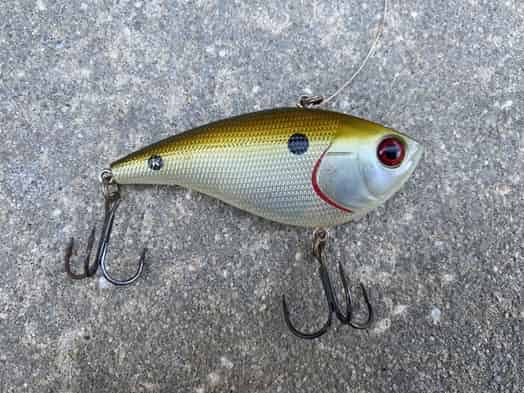
The lipless crankbait also shines when fished through grass, and water in the 45-60 degree range.
Round Bill Crankbaits
Round bill or deep diving crankbaits are great for fishing the deepwater you can’t reach with the other variations. The round bill dives much faster, and is extremely effective around sand and gravel when the bait is closer to the ground.
The Roundbill crankbaits do not deflect off structure as well as the square bill crankbaits however they are able to dive quicker, and have the ability to fish deeper depths.
When To Fish A Jerkbait vs Crankbait
With so many different variations of lip sizes, sinking rates, rattle or no rattle this task can seem daunting at times. How do you know which one to choose?
The following factors will help when you are choosing what variation of the bait to throw.
See Also: 12 Tackle Box Essentials Every Freshwater Angler Should Own
Match The Hatch
Matching the hatch can be a very important part to any fishing trip and any species of fish you are targeting. Matching the hatch effectively could be the difference between a great day on the water, and just a mediocre day on the water. Below are some factors to consider when matching the hatch.
Check Your Local Forage
Examine the forage in your body of water closely, if the predominant forage in your body of water is long, and slender (such as minnows or shiners) then a jerkbait may be what you want. If the forage is fat and small ie. Bluegill, shad, crawdads, tie on a crankbait.
Check your colors!
You only have access to what’s in your box when on the water so if you have a crankbait that better matches the forage color than a jerkbait, even though the forage in that body of water is long and slender, throw the crankbait. Sometimes the fish care more about color than profile.
Remember, part of the fun is experimenting and finding a lure that works!
Water Clarity
For a general rule the cleaner, and clearer water you want to be throwing a jerkbait. In ultra clear to slightly stained water the jerkbait excels! The jerkabit is designed more around color in the water versus a crankbait which is made to give off lots of action, and vibration.
However in dirty, and stained water the jerkbait is less effective as the fish cannot track them down, and find them as well. In dirty, and stained water pick up your crankbait.
The crankbait excels in dirtier water due to the vibrations it gives off in the water which help the fish locate your bait. In very muddy water try throwing a crankbait with a rattle in it, to give off even more noise, and vibration.
Water Depth
Water depth is a key element in determining when to throw a crankbait or a jerkbait. A jerkbait is a cadence bait, and can be fished in 1-12 feet of water extremely effectively. However when you get out of that 1-12 foot range the jerkbait becomes less effective.
When fishing in that 14-20 foot range of water the crankbait wil excel! With many different types of bills designed for shallower or deeper diving, the crankbait allows you to fish deeper depths accurately, and effectively.
Some crankbaits can even reach depths of 26+ feet!
How to Fish a Jerkbait vs. A Crankbait
One of the main differences between a jerkbait and a crankbait is the way you fish them. A jerkbait is a cadence bait meaning you can control the way it moves in the water by changing the way you move your rod, while to fish a crankbait you simply just “crank” the bait in at varying speeds.
How to Fish a Jerkbait
To fish a jerkbait cast your line out, and point your rod down at the water at a 4 o’clock position. Then snap your rod down to the water, or a 6 o’clock position. As you bring your rod back up to the four o’clock position reel in your slack, and repeat.
One thing that makes a jerkbait so effective is the fact that you can fish the bait with distinct cadences. Try fishing the bait with a jerk, pause, then a jerk, jerk, pause. The variances in your cadences will allow you to not only find what the fish are wanting, but also allow you to fish varying depths.
To fish varying depths with a jerkbait simply vary how fast you jerk your rod, or vary how long you let the bait sit on a pause.
On the jerks the bait will fire down in the water column, on the pauses the bait will suspend or slowly float to the top of the water depending on what kind of jerkbait you are fishing.
How to Fish a Crankbait
Fishing a crankbait is alot like it sounds just “cranking” the bait in. However there are a few factors you can change when fishing a crankbait.
Number one is you can change your retrieval speed, Crankbaits can be cranked fast for a faster sporadic movement, and wobble. Or when the fish are lethargic, reel the crankbait in slower, to give it a slower movement, and wobble.
Generally speaking you want to keep your rod tip pointing directly at the lure, and keep steady tension on your line to ensure a constant retrieve.
You can try slight pauses in your retrieve, but crankbaits are all about the ‘wobble’. Find that sweet spot that triggers strikes. Pay attention to your retrieval speed by counting how many times you turn your handle.
Closing Remarks
Although they are often lumped together in the same category, jerkbaits and crankbaits are two distinct lures meant for different fishing applications.
Once you really dive into the nuance of lure selection, you’ll the the amazing variety and options you have when chooseing between the two.
But, in the end it’s important to not overcomplicate choosing between the two baits. If one is not producing try a different variation! Keep it fun, experiment and pay attention to the results.
If your anything like me…you’ll have a few go to favorites that work time and time again.
Thanks for reading!
To see the exact jerkbaits and crankbaits I use, visit My Tackle Favorites.
If you haven’t guessed yet, I love fishing and everything about it!
To learn more about why I started Panfish Nation, visit the About page and follow along on Social Media:


Download a copy of my FREE Lure Color Selection Chart & Knot Guide!
Stay up to date with fishing reports, tackle reviews, industry news, and much more! We respect your privacy, unsubscribe at any time.
- Crazy Facts About the World Record Crappie

- What Size Hooks for Smallmouth Bass? Quick Guide

- Large and in Charge-Mouth: 10 of the Best Bass Lures of All Time (And Where to Buy Them)

- Emperor of the Sun(fish): What You Need to Know About the World Record Bluegill
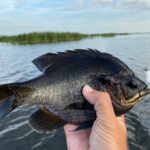
- The Seven Best Lures for Fall Bass Fishing
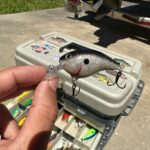
- Which Fishing Line is Best for Bass Fishing With A Spinning Reel?
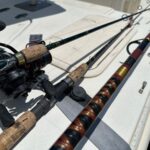
- What Size Hooks for Panfish?
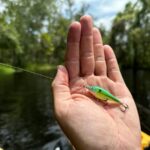
- Coppernose Bluegills: How They’re Different from Common Bluegill
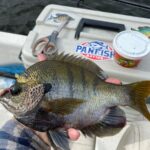
- Best Crappie Lakes In North Carolina
